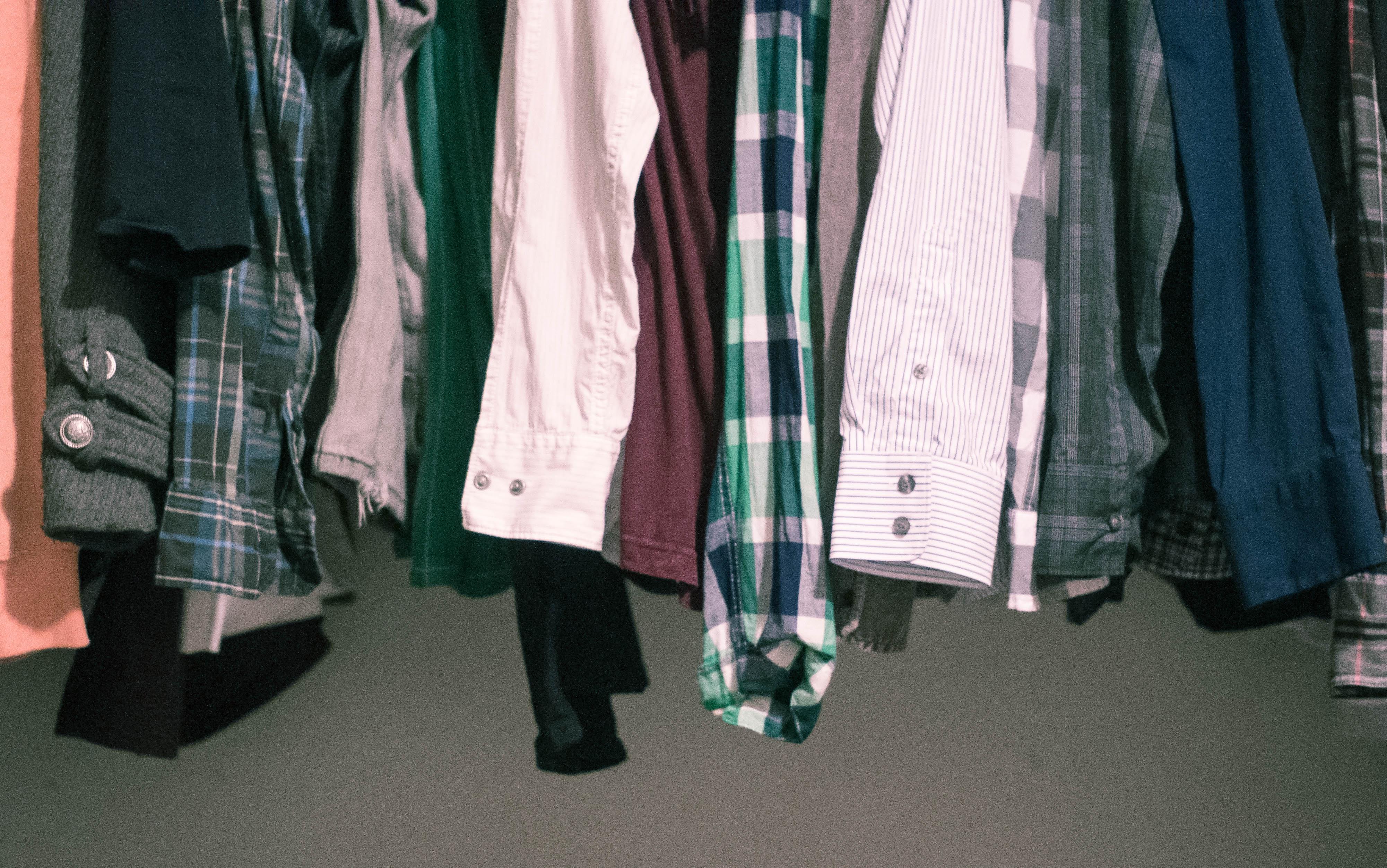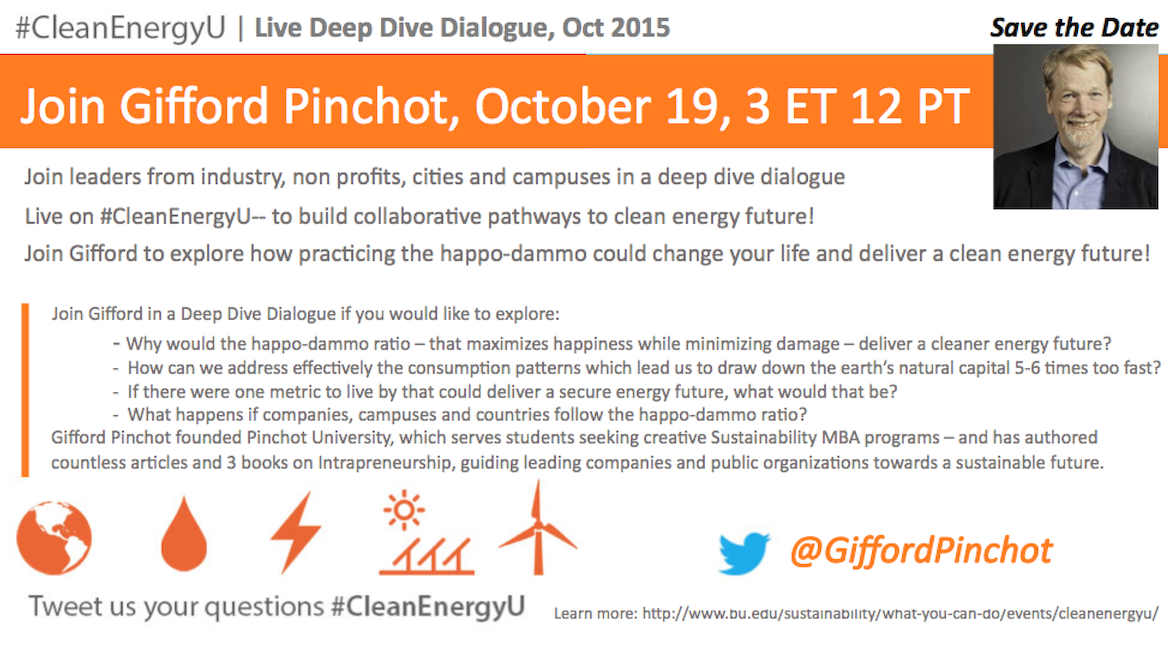Code Green Solutions


The emissions embedded in the stuff Americans buy every year is about equal to the emissions of all of our light vehicles
As we join Gifford Pinchot on Monday Oct 19 at 3pm ET for his #CleanEnergyU Deep Dive Dialogue, he will be asking how can we best we maximize our happiness while incurring the least damage to the planet and our clean energy future?
Steve Gutmann has been creating innovative ways to do just that – more joy, less impact – by sharing our stuff though his new Stuffstr app. The sharing economy recognizes that the very large carbon footprint embedded in the stuff we consume and store has to be better optimized: in Gifford’s language, we can find new ways to gain more happiness with less (or different kinds of) stuff.
As the Paris COP meeting approaches, I was asking myself recently what our individual carbon budget would need to be in order to stay within the world’s 450ppm CO2 limit? Answer: about 2.7 tons CO2 per person (about a tenth the US average). Can we get that low and that happy living in the United States? Want to join me in trying?
One thing I do know is that we can’t get there without managing better the carbon and energy embedded in our stuff… so it’s time to think creatively with entrepreneurs like Steve about how we consume both stuff and food… alongside our transportation and energy… to ask what makes us most happy? And how could we share a little more to optimize our own happo-dammo ratio?
So are you wondering how much happiness and damage is stored in your stuff? And what could be done about it?
Read on… And join Gifford Pinchot at 3p ET Monday Oct 19 at #CleanEnergyU for a Deep Dive Dialogue to explore how to live one’s life by the Happo-Dammo ratio.
And join Steve Gutmann and Giff again for our #CleanEnergyU Tweetathon Oct 21 at 1pm ET / 10am PT to explore how entrepreneurial solutions like Steve’s new Stuffstr app can help deliver a radically cleaner future!
—
The Carbon in our Stuff
By Steve Gutmann
When we think about carbon emissions we rightly focus on the power and transportation sectors, which are major contributors to our carbon footprints; however, we often forget about the third largest contributor: stuff. And even when we do think about the emissions embedded in our stuff, we tend to think about how to produce items more efficiently. Or whether and how to recycle them.
We rarely think about how intensively our stuff actually gets used during its lifetime.
Well, here are a few ugly stats…
This presents a massive opportunity, and that opportunity is starting to be addressed through a number of innovative business models and approaches, including:
The sharing economy, which uses technology to facilitate peer-to-peer sharing — or renting. Companies like Airbnb, Getaround, RelayRides and Spinlister are among the leaders in this field, but a quick visit to www.collaborativeconsumption.com reveals that there are hundred s of startups entering this space. For example, Spinlister allows my neighbors — as well as people visiting friends in my neighborhood — to rent my bike trailer, or trail-a-bike, or my all-grown-up-bike, for that matter, when I’m not using them. Note: My 10 and 13 year-old daughters routinely rent out their often-idle bikes for $20 a day this way — and they’ve already paid for their bikes 2-3 times over!
Remanufacturing. Caterpillar Reman does this with tractors. Apple does it with electronics. These companies buy back used equipment, test it and replace worn out of obsolete parts, slap a new warranty on them, and re-sell them. I bought a remanufactured MacBook Air for 40% off the retail price. I couldn’t even tell it had been used.
Streamlined resale. There are dozens of notable startups creating marketplaces to re-sell your old stuff. OfferUp, Letgo, Poshmark and the Nextdoor.com classifieds are a few successful examples. They’re taking on Craigslist by creating mobile-first platforms that make it super easy to post things for local (i.e. no packing or shipping required) resale. My own startup, Stuffstr.com, is a universal platform that captures all of a user’s purchases in a digital inventory, which makes posting things to these resale sites even easier.
What these companies all have in common is that they’re tapping into underutilized stuff. And if they succeed in, say, doubling actual use derived from a given object during its lifetime, that effectively halves that item’s embedded carbon per use.
And that’s a big deal.
So by all means support green energy and walk, bike, ride transit or drive an EV, but don’t overlook your neglected stuff. Release it from your attic, garage or basement, and set it free so that it gets to do what it wants to do: be used!
—
Convinced now that your happiness can increase and impacts decline by sharing more? Want to learn more about managing your embedded energy footprint?
Join Steve Gutmann and Gifford Pinchot at the #CleanEnergyU tweetathon on Oct 21 at 1 ET 10 PT to explore how entrepreneurial solutions like Steve’s new Stuffstr app can help deliver a radically cleaner future!
And Giff at 3pm ET on Monday Oct 19 at #CleanEnergyU for a Deep Dive Dialogue to explore how to actually live one’s life by the happo-dammo ratio to personally live the #CleanEnergyu future …
Just chime using the #CleanEnergyU hashtag to join the Twitter dialogue online.